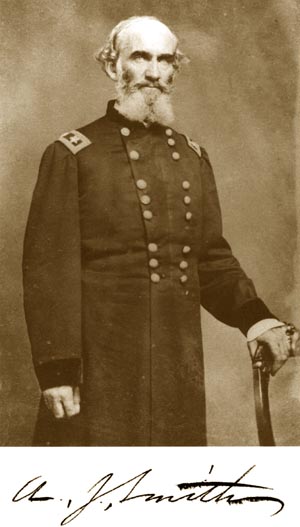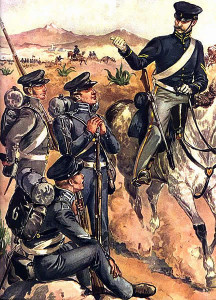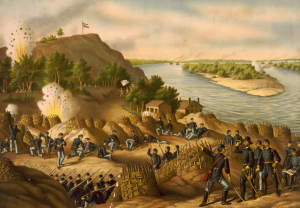
The signature is taken from a letter signed 11/18/1864. Both the photograph and the signature are from the collections of the US Army Military History Institute. (Digitally enhanced by Deborah Rice of St. Louis, MO)
A General Continuing to Live Life Well
General Andrew Jackson Smith
2911 Washington Avenue
Birth: April 28, 1815, Bucks County, Pennsylvania
Death: January 30, 1897, Saint Louis, Missouri (aged 81)
Burial: Bellefontaine Cemetery, Saint Louis, MO
Living one block south of Lucas and Garrison in 1875, General Andrew J. Smith, the then U.S. Postmaster for Saint Louis, was one of he most decorated and illustrious players in the Civil War.
SMITH, ANDREW JACKSON.—— The distinguished soldier and patriot who is the subject of this biography, inherited patriotic and war-like blood, and it was natural that he should find himself adapted to the life of a soldier; and that he should win honor and distinction amid the rush and destruction of battle, is but the fulfillment of the decree of heredity. His father, General Samuel Smith, won distinction and his title in the war of 1812. He was a friend of Lafayette, and was with that great Frenchman when he visited Philadelphia. The elder Smith was born in Bucks county in 1742. He owned a very fine farm on the Delaware, and after the war of 1812 he resigned his commission and returned to the farm, where he died in 1838, at the ripe age of ninety-six years.
The subject of this sketch was born just at the close of this second attempt of Great Britain to crush the Colonies. April 28, 1815, was the date of his birth, and the old county of Bucks, one of the three Pennsylvania counties settled by the Quakers in the sixteenth century, was his birthplace.
In the days of young Andrew’s youth the public school of the present day was unknown, but of course the best private institution of the times was to be had near home, as Philadelphia was at that time the center of civilization and culture for the western world. Therefore, the boy obtained the best education to be afforded by a private school in Philadelphia, at which institution he studied until his eighteenth year.
At that time, or in 1834, he was appointed a cadet by the great president after whom he was named—General Andrew Jackson. He entered West Point July 1, 1834, and graduated there from on July 1, 1838. He was given the commission of a second lieutenant, and served at Carlisle, Pennsylvania, at the school for cavalry practice during parts of 1838 and 1839. He was then put on recruiting service during parts of 1839 and 1840. In the latter part of the latter year he was sent 011 the expedition to the Pottawotomie country. During 1840, ’41 and ’42 he was located at Fort Leavenworth, except during a brief time in 1841, when he was ordered to Jefferson Barracks, St. Louis. He was ordered to Fort Gibson, Indian Territory, in 1843, and in the same year he was ordered to return to Fort Leavenworth, where he remained until 1845.
On March 4, 1845, he was created a first lieutenant of dragoons, and in the same year was ordered on an expedition to the Rocky mountains.
When the war with Mexico broke out, he was immediately ordered to the front, being the first lieutenant of a regiment commanded by General Stephen Kearney. Phil Kearney, after ward renowned as a great Indian fighter, was also in the command of General Stephen, who was his uncle. As young Phil likewise held the rank of a lieutenant, the young men became fast friends before the campaign had progressed very far.
The command had scarcely reached the seat of war when General Kearney was ordered to return to the East. Directly after this, Lieutenant Smith was ordered to Southern California to watch the interests of Uncle Sam, being stationed for garrison duty at San Diego during 1848.
On February 16, 1847, the young soldier was again promoted, he being made captain of the First Dragoons. In 1849, during the excitement and wild times incident to the discovery of gold, he was stationed at San Francisco. Within the next decade he was stationed at various points in California, Oregon and Washington, and engaged in many expeditions and campaigns against the Indians.
May 15, 1861, he was created a major of dragoons, and a little later was sent from Washington Territory on an expedition to the Nez Perces agency. While there he received a peremptory call to return to San Francisco, from which place he was at once ordered to Washington, where he was expected to assist in put ting down the rebellion. He at once embarked for New York, going by way of the Panama canal. Even in those days the trip from San Francisco to New York was not only expensive but tedious, requiring thirty days time to complete it.
Upon his arrival in Washington he was created major of cavalry on August 3, 1861. Only a few weeks after this, or on October 2, he was created colonel of the Second California Cavalry Volunteers, and with his command was ordered west to join the Army of the Tennessee, when he was appointed chief of both the cavalry departments of Missouri and Mississippi. This office he held until 1862.
On March 17, 1862, he was made a brigadier general of United States Volunteers. Then began a campaign unexampled in activity and hard fighting for the next three years. During 1862, 63 and ‘64 General Smith led his command over nearly all of Alabama, Mississippi, Arkansas and Tennessee, and during that time saw nearly as active service as falls to the lot of any soldier. He commanded a detachment of the Thirteenth and Sixteenth Corps part of the time, and the battles and skirmishes in which he gallantly led his troops are too numerous to mention here. However, it might be well to enumerate some of the chief engagements in which he participated. He was in the bloody siege of Corinth, and was in the van in the courageous assault on Chickasaw Bluffs; he was all through the tedious and dangerous siege of Vicksburg, and assisted at the capture of Port Gibson; he cheered his men up Champion Hill against the slaughtering fire of the enemy; he was the chief figure in the Red river campaign; and his bravery at the battle of Pleasant Hill, Louisiana, won him distinction; in May, 1864, he covered the rear of Banks’ retreat, and in the same year defended St. Louis from the threatened attack of Price; he was at Tupelo and Nashville, and in 1864 commanded a detachment of Thomas’ army in its campaign against Hood.
On April 10, 1864, he was made a brevet colonel, “for gallant and conspicuous bravery at the battle of Pleasant Hill, Louisiana.” May 9,1864, he was created lieutenant-colonel of the Fifth Cavalry, and three days later was made major-general of United States Volunteers. Again, at the battle of Tupelo, by his brave leadership in the assault on the enem_v he won distinction, and the title of brevet brigadier-general was conferred on him.
At the battle of Nashville he, for the third time, distinguished himself by his conspicuous gallantry, and was rewarded by having the title of brevet major—general conferred on him.
During 1865 he was in the campaigns in various parts of Alabama, was at the battle of Mobile and led the attack on Spanish Fort. He was mustered out of the volunteer service, January 15, 1866, and was made colonel of the Seventh Cavalry, regular army, July 28, 1866, the same regiment of which General Custer was then lieutenant-colonel. In 1867 and 1868 he was in command of the Upper Arkansas.
In 1872, his old commander, General Grant, recognizing the fact that a man who had rendered his country such signal service in war could not but prove a faithful servant in peace, appointed him postmaster of St. Louis. He, of course, resigned his commission in the army. He served the people of St. Louis four years, and made a most excellent civil official. Immediately after his term as postmaster had expired, General Smith was elected city auditor and served four years. General Smith is married to Miss Anna Simpson, daughter of Dr. Robert Simpson, of St. Louis. They have one son living, William Beaumont Smith, who has undoubted talent as an actor, and who has adopted the stage as his profession. He was a member of the Booth and Barrett company until the latter died and the company was thus broken up.
After a most active life as soldier and civilian, General Smith has now retired to his handsome home here in St. Louis- to rest and enjoy the honors he has earned.
Page 160, Old and New St. Louis, A Concise History of the Metropolis of the West and Southwest, with a Review of Its Present Greatness and Immediate Prospects, James Cox, Central Biographical Publishing Co., 1894
Smith resigned his volunteer commission in 1866 and became colonel of the U.S. 7th Cavalry Regiment, serving in the American West. He retired from the military service in April 1869 to become postmaster of St. Louis, Missouri, where he died on January 30, 1897. He was buried at Bellefontaine Cemetery in Saint Louis.


